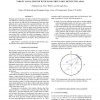Free Online Productivity Tools
i2Speak
i2Symbol
i2OCR
iTex2Img
iWeb2Print
iWeb2Shot
i2Type
iPdf2Split
iPdf2Merge
i2Bopomofo
i2Arabic
i2Style
i2Image
i2PDF
iLatex2Rtf
Sci2ools
ICASSP
2011
IEEE
2011
IEEE
Target localization with NLOS circularly reflected AOAS
Bearings-only localization with light-of-sight (LOS) propagation is well understood. This paper concentrates on bearing-only localization with non-line-of-sight (NLOS) measurements, where the target radiation arrives at the sensor after a specular reflection. The wrinkle is that the reflecting surface is circular (inner side of a circle), and is assumed known. Since the target-sensor geometry has multiple configurations, the maximum likelihood (ML) solution may not exist. However, if a concentric opaque circle (such as the earth) exists within the reflecting one, the propagation path is unique; a grid search based ML is available for such a circumstance. Since ML is computationally consuming, two suboptimal algorithms based on small angle approximation are developed. Their performances are numerically compared.
Concentric Opaque Circle | ICASSP 2011 | Signal Processing | Small Angle Approximation | Target Radiation |
| Added | 20 Aug 2011 |
| Updated | 20 Aug 2011 |
| Type | Journal |
| Year | 2011 |
| Where | ICASSP |
| Authors | Xiufeng Song, Peter Willett, Shengli Zhou |
Comments (0)

